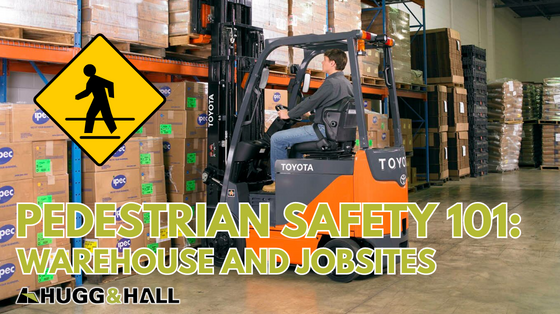
Pedestrian Safety 101: Warehouses & Jobsites
Imagine: you’re finishing up a shift in a warehouse or on a construction site. You’re tired and decide to take a shortcut across an area where equipment is running. You figure that you’ve got quicker reflexes than the equipment, so you’ll be fine. But a quick shortcut can cause you significant harm.
Forklifts and construction equipment pose inherent dangers to pedestrians. According to data from OSHA and the Bureau of Labor and Statistics, construction sites and warehouses are two of the most dangerous places of employment.
How do you help keep yourself safe when you share a worksite with forklifts and construction equipment? Whether you work in a warehouse or in construction, follow these tips to help keep yourself safe on the job.
If you work in a warehouse, you know that forklifts are necessary for daily operations. When you work with equipment regularly, it’s easy to forget how dangerous it can be. Your team should be aware of forklifts and other machinery, and your operators should be aware of pedestrians.
In a warehouse, you can give your team the added security of a consistent environment. You can do this by:
- Designating and marking pedestrian walkways out of the path of forklifts.
- Restricting specific areas to forklift traffic only.
- Adding handrails to increase pedestrian safety.
- Limiting overhead door access to forklifts.
However, designated pedestrian areas don’t mean your forklift operators don’t have to pay attention. Even when the environment is consistent, people are the changing variables. It’s important that all forklift operators stay vigilant. They can do this by:
- Looking out for pedestrians.
- Shouting a warning and honking the horn at intersections, corners, and blind spots.
- Using overhead and rear-view mirrors on forklifts.
- Ensuring alarms and flashing signals are working on all forklifts. In need of alarms or signal lights? Contact our Parts Department to find the ones you need.
- Always yielding the right-of-way to pedestrians.
Learn more about forklift safety add-ons to help keep your team safe.
Forklift safety requires additional attention from both operators and pedestrians. By ensuring the forklifts in your environment have the correct safety features, your operators are aware and cautious, and your pedestrian traffic knows where the safe-zones are, you can help pedestrians avoid injury.
A construction site offers additional pedestrian hazards for a variety of reasons. Beyond ensuring that fellow employees avoid equipment, you have to keep the general public out of your jobsite.
There are rarely consistent “safe zones” for pedestrians on a jobsite, so awareness of your surroundings is vital.
You can limit pedestrian hazards on your jobsite by doing the following:
- Putting up fencing, and maintaining it regularly, to keep the general public out of your jobsite.
- Maintaining a clean, tidy jobsite. A tidy work area reduces the risk of slips, trips, and falls, and reduces the risk of fire hazards. Always keep access routes clear.
- Marking unsafe work areas and ensuring employees don’t cross into unsafe areas.
On a construction site, operators don’t have the tight corners of a warehouse to worry about. However, since pedestrians can approach from all sides, equipment operators often have to be even more vigilant. Operators can help warn foot traffic of their approach by:
- Installing equipment alarms and flashing signals. On a noisy construction site, flashing signals can be one of the best ways to get an employee’s attention.
- Ensuring equipment has mirrors and always checking blind spots.
- Providing adequate lighting if workers are present after dark.
- Clearing the area before lifting objects, and making sure all loads are secured before lifting.
Construction sites are inherently dangerous, but you can help keep employees safe on the job with these tips.
Back to News
Subscribe and unlock cutting-edge equipment insights, trends and tips!
Subscribe


